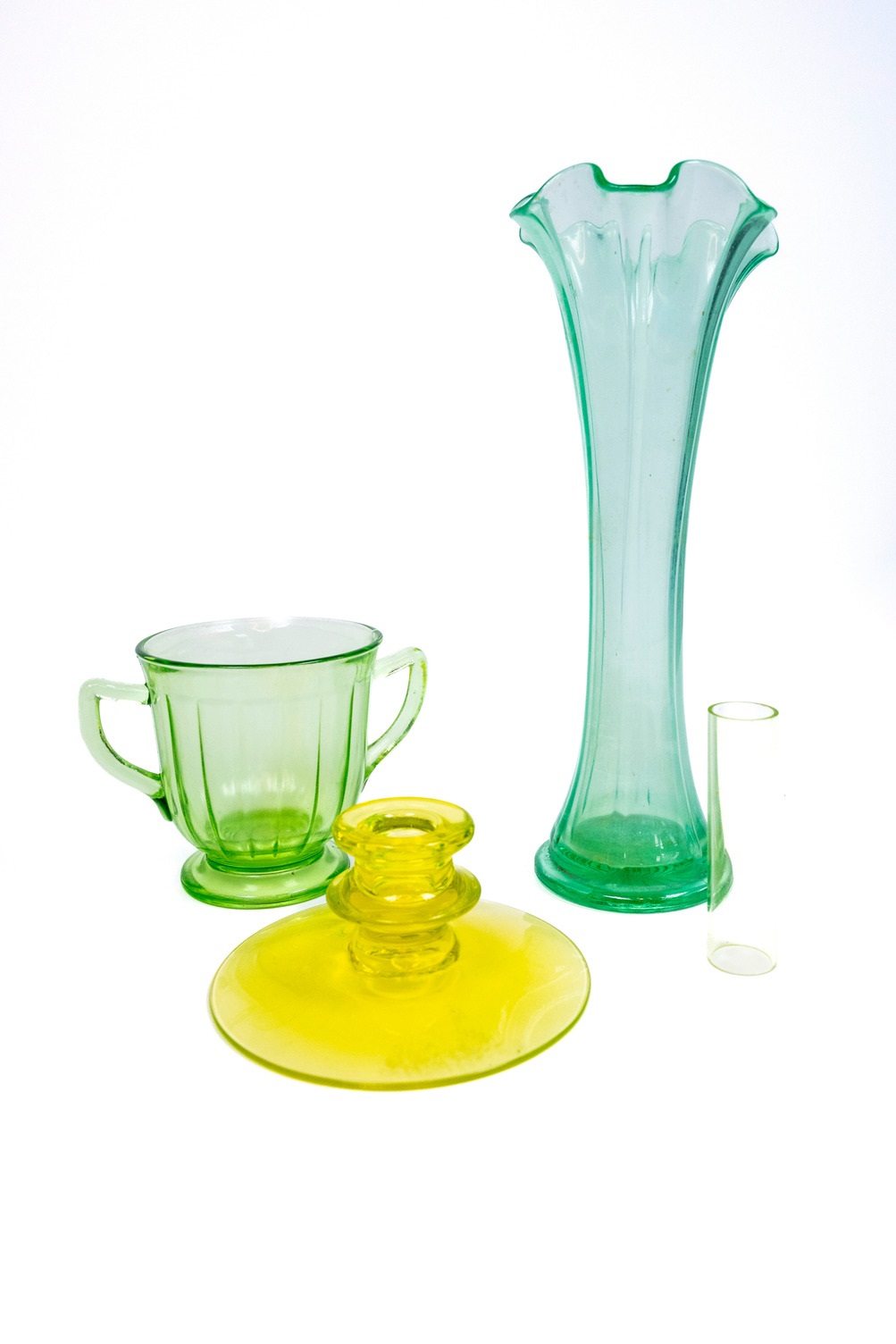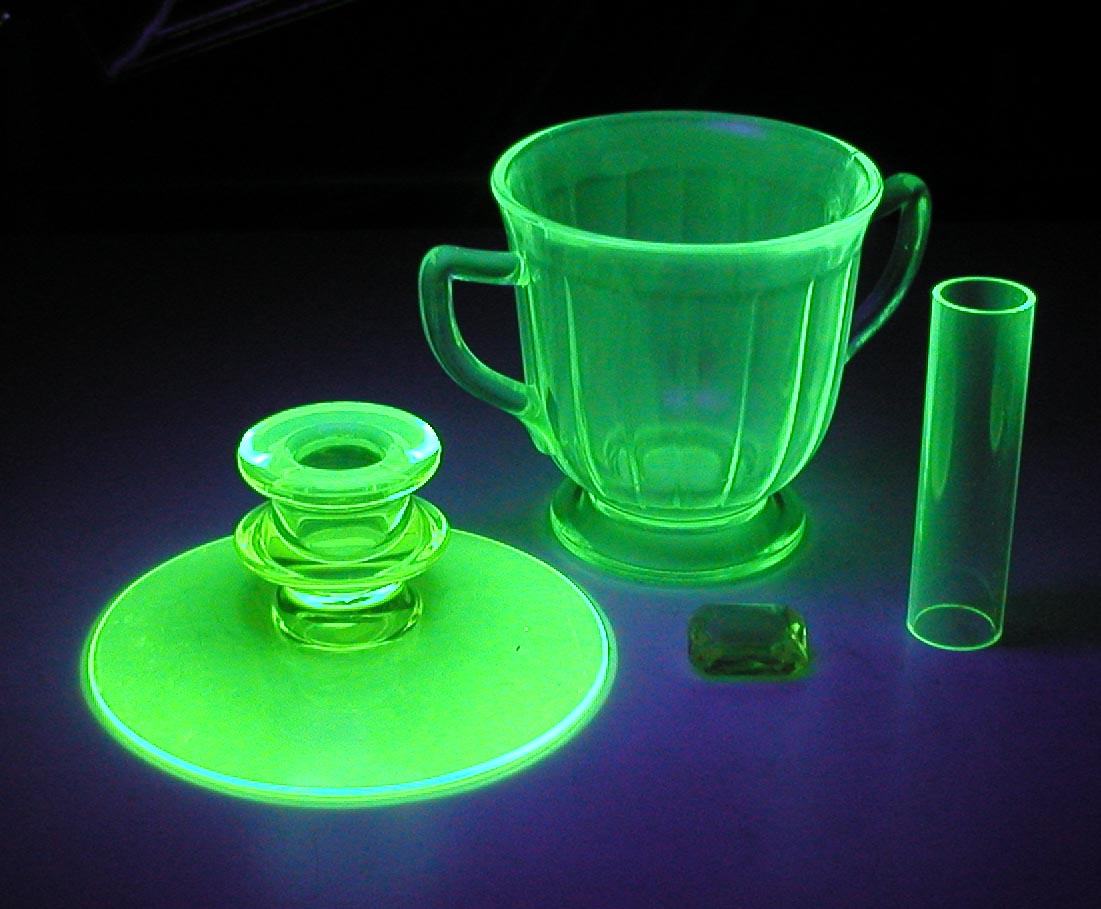
ORAU’s Museum of Radiation and Radioactivity includes uranium glass.
We’ve already written about common household items that contain uranium on our blog, but uranium glass deserves its own post because it’s the most viewed item in ORAU’s online Museum of Radiation and Radioactivity. With so many page views, we decided to divulge more information about these products. Whether you’re generally curious, are looking for information about uranium glass safety, or want to know the value of the glass you found at grandma’s house, we’ll try to cover the bases.
Background
Uranium glass is also known as Vaseline glass because of its translucent yellow-green color (like petroleum jelly). It’s a type of glassware that contains uranium dioxide, which is what gives its characteristic fluorescent green or yellow color. This type of glass was particularly popular in the late 19th and early 20th centuries. Its production declined significantly after World War II, partly due to the redirection of uranium supplies for military purposes, namely the development of nuclear weapons.
History of uranium glass
According to the Corning Museum of Glass, the history of uranium glass can be traced back to Europe in the 1830s, and it gained popularity during the Victorian era (1837-1901). It was used in tableware, beads and decorative objects. Glass is produced by mixing silica sand, soda ash, and limestone and then melting it in a furnace to be shaped. Uranium glass is created by adding uranium oxide to that mixture. Josef Riedel, a prominent European glassmaker, is credited as the first to produce uranium glass. He named the yellow color Annagelb and the green color Annagrun after his wife, Anna. (Gelb is yellow and grun is green in German.)
Glassmakers used natural uranium for more than 100 years until the war-effort demand for uranium increased to the point of halting production of uranium glass. After a 15-year hiatus (and growing radiation danger awareness and regulation), craftsmen resumed making uranium glass. At this point, though, they used depleted uranium, which is less radioactive. Today, only a small number of glassmakers continue to produce uranium glass items (but not dinnerware), catering to niche markets of collectors and historical enthusiasts.
Radiation levels

The small tube on the right was made using depleted uranium while the other items pictured were crafted with natural uranium.
You may be wondering about any adverse effects of people handling and eating/drinking from uranium glassware for a century-plus. Think about it: if it glows in the dark (fluoresces) should you be consuming food and beverage from it? Dr. Paul Frame, retired ORAU health physicist explains that fluorescence is a visual effect resulting from the interaction of UV light with the uranium in the glass. It’s a characteristic feature of uranium glass and is used to identify it. Frame is also the curator of ORAU’s Museum of Radiation and Radioactivity.
The United States government released a detailed analysis of radiation exposures from uranium glass products in the Systematic Radiological Assessment of Exemptions for Source and Byproduct Materials.
The analysis concluded that the highest doses would be to the personnel involved in the transportation of the glassware from a manufacturer to a truck distribution center. For these people, the maximum estimated dose is 1 to 2% of the average American’s annual radiation exposure. This tells us the level of radioactivity in uranium glass is generally considered very low and not harmful under normal handling and use. Even so, it’s important to handle uranium glass with care as you would any radioactive product, and never use uranium glass as dinnerware or drinkware.
Value

Though there are a few exceptions, one of the most reliable ways to identify the presence of uranium in the glass is to expose it to ultraviolet light.
After the radioactivity question, your next inquiry may be how much can a uranium glass item fetch? As with all collectibles, market value ebbs and flows, but there are a handful of criteria you should consider: rarity, condition, craftsmanship, size, historical significance, color and glow. According to Back Porch Antiques store in Greeneville, Tenn., common items might sell for from $10 to $50, whereas large vases or intricate figures or items from renowned manufacturers could command anywhere from several hundred to even a few thousand dollars!
Did this blog answer your questions and curiosities? For more information about Vaseline and uranium glass, visit our ORAU’s online Museum of Radiation and Radioactivity. Starting in February 2025, you can also see the collection in Pollard Center on ORAU’s main campus in Oak Ridge, Tenn.
You can read more about other common household items that contain uranium on our blog.
References:
- Home | Corning Museum of Glass
- Systematic Radiological Assessment of Exemptions for Source and Byproduct Materials